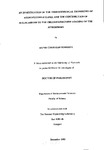AN INVESTIGATION OF THE THERMOPHYSICAL PROPERTIES OF HYDROFLUOROALKANES, AND THE CONTRIBUTION OF HALOCARBONS TO THE CHLORINE/BROMINE LOADING OF THE ATMOSPHERE
| dc.contributor.author | DOWDELL, DAVID CHRISTIAN | |
| dc.contributor.other | School of Geography, Earth and Environmental Sciences | en_US |
| dc.date.accessioned | 2013-09-16T11:52:09Z | |
| dc.date.available | 2013-09-16T11:52:09Z | |
| dc.date.issued | 1993 | |
| dc.identifier | NOT AVAILABLE | en_US |
| dc.identifier.uri | http://hdl.handle.net/10026.1/1756 | |
| dc.description.abstract |
A capillary flow gas viscometer has been used to measure the shear viscosities of the hydrofluoroalkanes HFC 134a, HCFC 123, HCFC 124 and the ternary blend MP 39, at pressures up to 0.1 MPa relative to a nitrogen standard. Having applied small correction factors to the measured flow time data, the resultant viscosities are compared to those obtained by other workers (where possible) using alternative techniques. We calculate self diffusion coefficients and hard sphere collision diameters for the molecules within the rigorous Chapman-Enskog kinetic theory of gases, and calculate optimum well depths of the intermolecular interactions using the Extended Law of Corresponding States. The use of a Stockmayer potential energy function by other workers is discussed and within this, the Mason-Monchick approximation is applied to calculate the percentage effect of the dipole moment on the collision integral. In order to assess the affect to the atmospheric chlorine loading of the hydrochlorofluorocarbons measured above (HCFC 123. HCFC 124 and HCFC 22 in MP 39) as well as other halocarbons currentiy in use, two globally averaged mass balance models have been developed on a workstation spreadsheet to assess the future chlorine and bromine levels in the atmosphere and the sensitivity of those loadings to possible forcing factors. These models use production, growth, lifetime and concentration data for fourteen chlorocarbons and three bromocarbons and allow for characteristic emission profiles according to the use to which the halocarbon is applied. Current international agreement, ie. Montreal Protocol 3, is used as a reference level (in most cases), and the models have been used to assess tiiose scenarios which most influence the peak level of chlorine and bromine attained, when that peak occurs and the period of time before 'safe' levels are reached. | en_US |
| dc.description.sponsorship | The National Engineering Laboratory, East Kilbride, Glasgow | en_US |
| dc.language.iso | en | en_US |
| dc.publisher | University of Plymouth | en_US |
| dc.title | AN INVESTIGATION OF THE THERMOPHYSICAL PROPERTIES OF HYDROFLUOROALKANES, AND THE CONTRIBUTION OF HALOCARBONS TO THE CHLORINE/BROMINE LOADING OF THE ATMOSPHERE | en_US |
| dc.type | Thesis | |
| plymouth.version | Full version | en_US |
| dc.identifier.doi | http://dx.doi.org/10.24382/4353 | |
| dc.identifier.doi | http://dx.doi.org/10.24382/4353 |
Files in this item
This item appears in the following Collection(s)
-
01 Research Theses Main Collection
Research Theses Main


